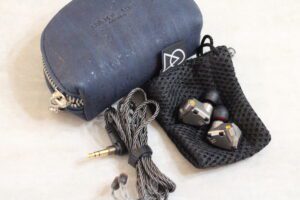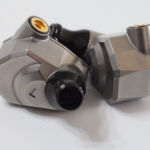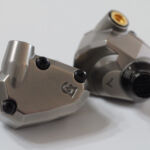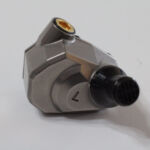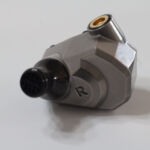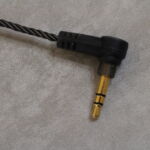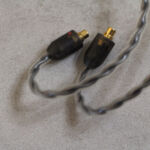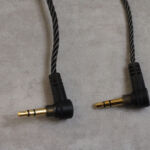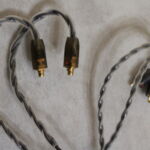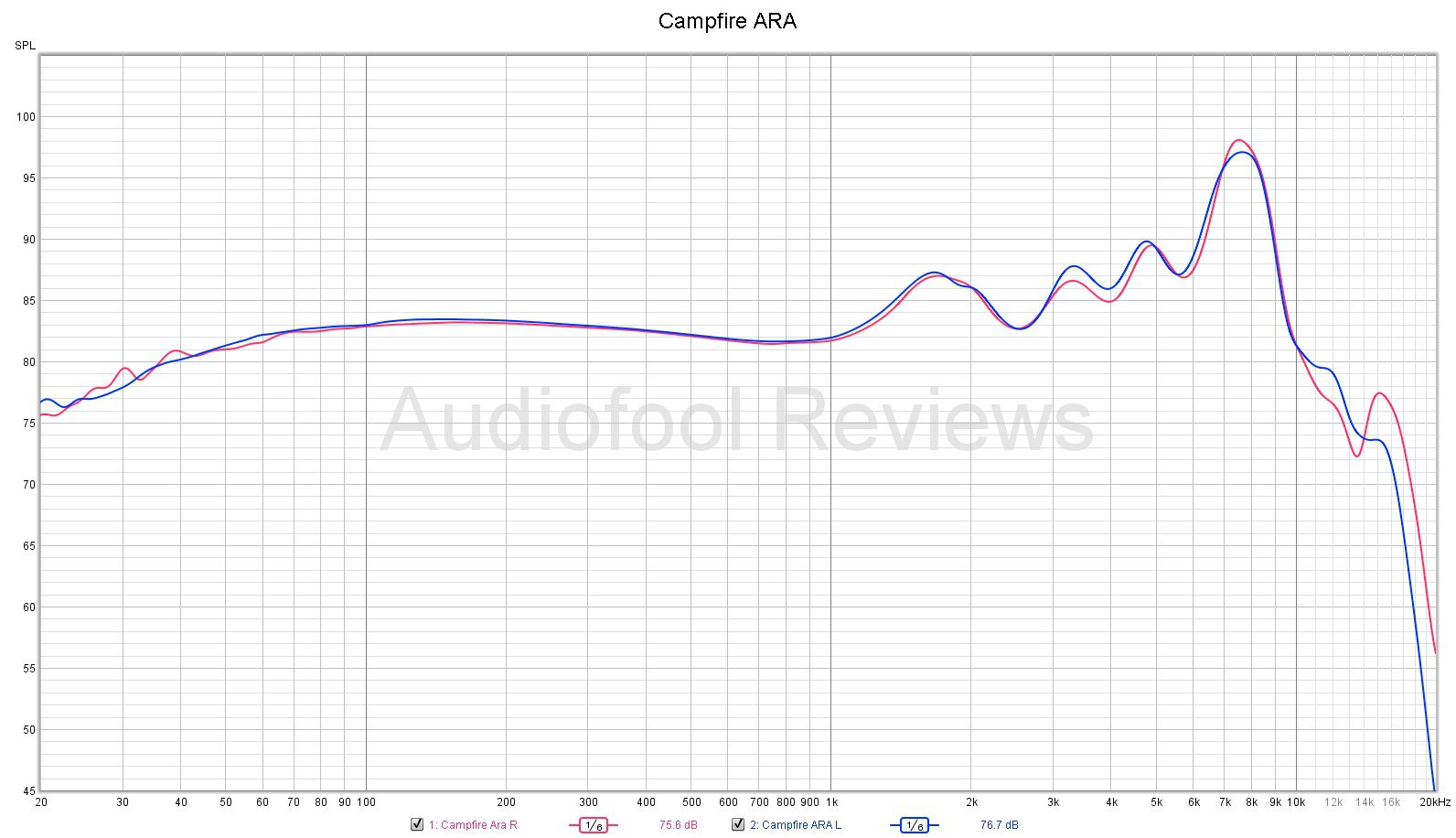Campfire ARA
Disclaimer: I was sent the Andromeda 2020, the Solaris 2020, and the Ara as part of a review tour. I was not compensated for this in any way, nor did I get to keep any of the products reviewed. If you have an interest in Campfire products, please check out their website or facebook page.
Unboxing / Packaging:
We can skip this section as all three models arrived in their respective soft cases with the cable and earpieces inside each. Each also have a small two pocket bag that prevents the earpieces from rubbing together during storage to prevent scratches. Campfire has provided good cases for their iems since the outset and the latest models share that although it does make it tough to grab the one you want in a hurry as no labels exist to identify the model from the outside. Case color helps but in the short time I had the Campfire’s I didn’t memorize which color was which.
Build/Fit:
At first glance, the ARA looks like an Andromeda that somebody forgot to anodize, but the shell is actually milled from a titanium billet and left raw intentionally so although the two models so share a similar shape, the materials used are almost completely different. Nozzles may be the same although the ARA uses the PVD coating of the Solaris shell on the nozzle to give it a nice offset and match the case screws. The mix of copper and metal gray give the ARA an industrial look that conveys an all business feel. Shells are very slightly heavier than the aluminum version but once in ear any difference in shape, size, or weight is not noticeable. I found the ARA comfortable for long wear and a bit better isolating than the Andromeda probably partially due to the higher density of the shell used.
Internals:
The ARA is an all balanced armature model with a quartet of drivers for lows, a single mid driver, and a pair of high frequency drivers all held in place in the 3d printed TAEC guide that provides alignment and channels for the sound to follow. The Ara has a nominal impedance of 8.5Ω and a sensitivity of 94 dB/mW. An impedance that low makes it almost imperative that the source device have a near zero output impedance to pair well and so the issue becomes not the output power of phones and tablets, but the output impedance that may not be entirely suitable for the ARA. I found impedance to range between 7 and 34Ω in my testing which puts the Ara in the lowest possible impedance category. It is easy to drive well from anything with adequate power, but impedance mismatching is quite possible so source selection should be approached with caution.
Cable:
The standard litz cable that ships with the ARA starts with a 90º 3.5mm jack with good strain relief before exiting as a 4 wire twist up to the splitter. The splitter is black aluminumc with a matching chin slider (although it appears to be plastic). From the splitter up the two wire twists are a looser twist than the 4 wire below and terminate with ear-hooks and mmcx connectors marked R/L for reference. There is no red dot so one has to find the labels which are somewhat hidden. The cable is well made, and durable, but honestly I’d prefer the heavier super Litz that ships with the Solaris. At first glance the two cables look very much alike but the super litz is heavier with twice the strand count of the standard. One has to wonder if the Super Litz is the premium cable, why it isn’t the default on iems with an asking price of over $1000. The 1st set of photos below are the stock cable, followed by a compare of the Litz vs the Super Litz.
Below is a comparison of the Litz vs Super Litz cables with the Super on left (or bottom in the case of the splitters photo).
Sound:
Bass:
With 4 bass drivers, you’d be forgiven for expecting a bass monster here. That isn’t the case at all. The Ara has some sub-bass but typical of balanced armature bass, it is fast and clean, but lacking some impact compared to things like Solaris with its dynamic driver. Mid-bass is more present and again very fast and clean with no bleed and little or no tendency to compress. Bass isn’t the emphasis here, but it can be considered one of the stars as it is extremely detailed, clean, and textured. Some will criticize the lack of sub-bass emphasis, but for those looking for a super-detailed reference tuning, its hard to argue against.
Mids:
Lower mids transition very cleanly from the mid-bass with no perceptible bleed and only a hint of warmth that helps give male vocals a more natural timbre. Guitar growl is good with sharp edges and good definition as well. There is a small push as you move toward the upper mids that adds some energy to female vocals and pushes them a step forward of their lower counterparts. This push can be both a good and bad thing though. Violins for example can sound fabulous on the Ara but can get a little overly energetic in the upper registers. Same thing goes with piano, most of the way through its range it sounds as good as any iem I have heard to date, but toward the top end it can get a bit brittle.
Treble:
Lower treble actually drops back a little after the upper-mid push before the true treble range climbs back up to the level of the upper-mids. This tuning adds some energy with out adding a lot of stridency or sharp edges to the treble and is opposite of what we see in a lot of models where the lower treble is quite pronounced and then fades as you climb. The Ara has its largest departure from linear in the 7-8kHz range where it has more energy than absolutely necessary but does give the Ara a nice open top end with some sparkle in the process. It drops back quickly before moving into a range where I find things get really fatiguing at between 9-10kHz which is a plus but that same 7-8kHz push may be too much for others who are more sensitive to that range. Snare rattle is good with crisp edges and well defined features. Cymbals have good energy and I actually prefer this tuning to any of the other Campfire models I have tried for highhat and crash cymbals.
Soundstage / Imaging:
Stage is quite good with slightly more width than depth and a good sense of height although I didn’t feel it reached quite the dimensions of the Andromeda 2020. This is one of those cases where it probably suffers due to comparison to its sibling as it is quite good, just not as spectacular as the Andro. Seating the orchestra is straight forward as layering and instrument separation are both well above average. Imaging is also very good with movements easily tracked and precisely placed on stage. This is a strong suit for the Ara for sure and again, had I not has its sibling to compare against I might have found it even better.
Comparisons:
Since they sent all three of the top models, it seems only fitting that I try and answer the “So which one should I get?” question that will come up for anyone perusing the Campfire website with cash in hand.
Andromeda 2020:
The Ara looks and feels like the Andromeda 2020 in hand and the two ship with the same accessories as well (including the same cable) so separating the two on physical attributes is a near impossibility unless you just love green or grey or are a big titanium fan.
Andromeda 2020 and Ara are both about equally easy to drive and both can be susceptible to hiss on high powered sources so again no huge separation there. Sound wise, the Andromeda has a bit more detail and a bit hotter treble compared to a bit more bass on the Ara (not surprising with a quad of bass tuned BA) and a more polite upper range. Both sound like all BA models in that bass is very clean and fast, but not as impactful as possible although the Ara does mitigate that to a degree. If you are looking for even more slam and rumble, there is always Solaris. Mids are a bit more linear on the Ara compared to the upper-mid push of the Andromeda, which makes the Ara a bit less strident and the better tuning for those sensitive to sibilance. I really enjoyed the Andromeda more than the Ara for a long period and actually wondered why they had made the Ara rather than focusing on the other models, but then, I ran into a couple live tracks that really showed off the Ara’s capabilities. This is where Ara comes to life and shines compared to the Andro with the the Ara giving a more realistic performance and the Andro feeling more controlled and processed comparatively.
Solaris 2020:
The Solaris 2020 is a slightly larger than either of the other two and has a different shape so fit may favor either the Andro/Ara or Solaris2020 and it is worth auditioning these before purchase although I found the 2020 version much more comfortable than the original Solaris. Build quality is roughly the same between so again no huge point scored on build but the Super Litz cable is a step up on the Solaris so that is points in its favor. The Solaris2020 with its dynamic driver is capable of a bit more slam and a bit thicker presentation than either of the other two produce, but sacrifices a touch of speed in the lows to do that and won’t produce quite as clean tone with exceptionally busy passages as a result. The biggest difference in the Solaris2020 vs Andro2020 and Ara is that the Solaris seems to be tuned for as smooth and effortless a delivery as possible while being willing to sacrifice a few micro-details and a bit of imaging in order to be able to reach that. The Andro2020 and Ara on the other hand are not quite as smooth or effortless, but bring a bit more detail and improved imaging to the picture in the trade off.
Thoughts / Conclusion:
The Ara is a bit of an enigma to me. It uses four BA bass drivers, but is a neutral tuning (for the most part), It is a near reference tuning that does its best work with live music where it can really show off its chops, It shares a ton of features with the Andromeda 2020, but has a tonality unlike anything Campfire has released to date. Certainly, the Ara is not what I was expecting when I opened the package. Having said that, I like what it is perhaps better than what I expected. I expected a tough choice to make between the Andromeda and Ara and instead I got two very different in-ears. The Ara does have more bass but only enough to go from light to neutral and not enough to muddy up anything. It has more mids than Andromeda, and the treble is tuned very differently. Some with treble sensitivity may need to audition the Ara before purchase as it does have a good bit of energy in the 7-8kHz range. Others will find that by moving the treble push up from lower to mid, some of the plasticity associated with female vocals is gone and it maintains a nice open stage (albeit smaller than Andro). I really came away with a respect for the Ara as a near neutral in ear with a fantastic build and great tonality. I just wish they’d put the Super Litz in the box on a $1000+ in-ear.
-
Bass - 8/108/10
-
Mids - 7.5/107.5/10
-
Treble - 8/108/10
-
Soundstage - 7.5/107.5/10
-
Imaging - 8/108/10
Summary
Pros: near neutral signature, Great tonality for live music, Titanium shell is super durable
Cons: Price, cable could be better, not as lively as others in Campfire line.


